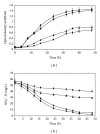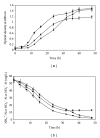Simultaneous heterotrophic nitrification and aerobic denitrification by Chryseobacterium sp. R31 isolated from abattoir wastewater
- PMID: 24991552
- PMCID: PMC4060765
- DOI: 10.1155/2014/436056
Simultaneous heterotrophic nitrification and aerobic denitrification by Chryseobacterium sp. R31 isolated from abattoir wastewater
Abstract
A heterotrophic carbon utilizing microbe (R31) capable of simultaneous nitrification and denitrification (SND) was isolated from wastewater of an Indian slaughterhouse. From an initial COD value of 583.0 mg/L, 95.54% was removed whilst, from a starting NH4 (+)-N concentration of 55.7 mg/L, 95.87% was removed after 48 h contact. The concentrations of the intermediates hydroxylamine, nitrite, and nitrate were low, thus ensuring nitrogen removal. Aerobic denitrification occurring during ammonium removal by R31 was confirmed by utilization of both nitrate and nitrite as nitrogen substrates. Glucose and succinate were superior while acetate and citrate were poor substrates for nitrogen removal. Molecular phylogenetic identification, supported by chemotaxonomic and physiological properties, assigned R31 as a close relative of Chryseobacterium haifense. The NH4 (+)-N utilization rate and growth of strain R31 were found to be higher at C/N = 10 in comparison to those achieved with C/N ratios of 5 and 20. Monod kinetic coefficients, half saturation concentration (K s ), maximum rate of substrate utilization (k), yield coefficient, (Y) and endogenous decay coefficient (K d ) indicated potential application of R31 in large-scale SND process. This is the first report on concomitant carbon oxidation, nitrification, and denitrification in the genus Chryseobacterium and the associated kinetic coefficients.
Figures







Similar articles
-
Heterotrophic nitrogen removal by Acinetobacter sp. Y1 isolated from coke plant wastewater.J Biosci Bioeng. 2015 Nov;120(5):549-54. doi: 10.1016/j.jbiosc.2015.03.015. Epub 2015 Apr 21. J Biosci Bioeng. 2015. PMID: 25910961
-
Simultaneous nitrification and denitrification by Pseudomonas sp. Y-5 in a high nitrogen environment.Environ Sci Pollut Res Int. 2022 Oct;29(46):69491-69501. doi: 10.1007/s11356-022-20708-x. Epub 2022 May 14. Environ Sci Pollut Res Int. 2022. PMID: 35562612
-
Complete nitrogen removal via simultaneous nitrification and denitrification by a novel phosphate accumulating Thauera sp. strain SND5.Water Res. 2020 Oct 15;185:116300. doi: 10.1016/j.watres.2020.116300. Epub 2020 Aug 13. Water Res. 2020. PMID: 32823196
-
Isolation and characterization of heterotrophic nitrifying and aerobic denitrifying Klebsiella pneumoniae and Klebsiella variicola strains from various environments.J Appl Microbiol. 2018 May;124(5):1195-1211. doi: 10.1111/jam.13703. Epub 2018 Feb 26. J Appl Microbiol. 2018. PMID: 29356236
-
Role of heterotrophic nitrifiers and aerobic denitrifiers in simultaneous nitrification and denitrification process: a nonconventional nitrogen removal pathway in wastewater treatment.Lett Appl Microbiol. 2022 Feb;74(2):159-184. doi: 10.1111/lam.13553. Epub 2021 Oct 19. Lett Appl Microbiol. 2022. PMID: 34402087 Review.
Cited by
-
Microbial community and performance of a partial nitritation/anammox sequencing batch reactor treating textile wastewater.Heliyon. 2021 Nov 20;7(11):e08445. doi: 10.1016/j.heliyon.2021.e08445. eCollection 2021 Nov. Heliyon. 2021. PMID: 34901500 Free PMC article.
-
Denitrification Characteristics of the Low-Temperature Tolerant Denitrification Strain Achromobacter spiritinus HS2 and Its Application.Microorganisms. 2024 Feb 23;12(3):451. doi: 10.3390/microorganisms12030451. Microorganisms. 2024. PMID: 38543502 Free PMC article.
-
Antimicrobial activities of actinomycetes isolated from unexplored regions of Sundarbans mangrove ecosystem.BMC Microbiol. 2015 Aug 21;15:170. doi: 10.1186/s12866-015-0495-4. BMC Microbiol. 2015. PMID: 26293487 Free PMC article.
-
Nitrogen Removal Characteristics of Pseudomonas putida Y-9 Capable of Heterotrophic Nitrification and Aerobic Denitrification at Low Temperature.Biomed Res Int. 2017;2017:1429018. doi: 10.1155/2017/1429018. Epub 2017 Feb 15. Biomed Res Int. 2017. PMID: 28293626 Free PMC article.
-
Simultaneous Heterotrophic Nitrification and Aerobic Denitrification of Water after Sludge Dewatering in Two Sequential Moving Bed Biofilm Reactors (MBBR).Int J Environ Res Public Health. 2022 Feb 6;19(3):1841. doi: 10.3390/ijerph19031841. Int J Environ Res Public Health. 2022. PMID: 35162866 Free PMC article.
References
-
- Bustillo-Lecompte CF, Mehrvar M, Quiñones-Bolaños E. Combined anaerobic-aerobic and UV/H2O2 processes for the treatment of synthetic slaughterhouse wastewater. Journal of Environmental Science and Health Part A. 2013;48(9):1122–1135. - PubMed
-
- Mees JBR, Gomes SD, Hasan SDM, Gomes BM, Boas MAV. Nitrogen removal in a SBR operated with and without pre-denitrification: effect of the carbon: nitrogen ratio and the cycle time. Environmental Technology. 2014;35(1):115–123. - PubMed
-
- Filali-Meknassi Y, Auriol M, Tyagi RD, Comeau Y, Surampalli RY. Design strategy for a simultaneous nitrification/denitrification of a slaughterhouse wastewater in a sequencing batch reactor: ASM2d modeling and verification. Environmental Technology. 2005;26(10):1081–1100. - PubMed
-
- Meyer RL, Zeng RJ, Giugliano V, Blackall LL. Challenges for simultaneous nitrification, denitrification, and phosphorus removal in microbial aggregates: mass transfer limitation and nitrous oxide production. FEMS Microbiology Ecology. 2005;52(3):329–338. - PubMed
Publication types
MeSH terms
Substances
LinkOut - more resources
Full Text Sources
Other Literature Sources
Molecular Biology Databases

